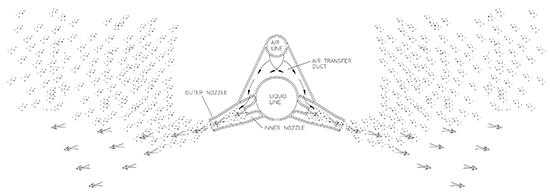
BIOLOGICAL REACTION
To provide the oxygen source for the biological reaction, a jet aeration manifold with multiple jet nozzle assemblies is connected to a pump and a blower. Each jet has a primary mixing nozzle and an outer secondary nozzle. The tank contents are re-circulated by the pump through the primary mixing nozzle. Low pressure air is mixed with the liquid in the outer secondary nozzle creating fine bubbles. By turning off the blower connected to the airline, anoxic mixing can be achieved with the same equipment to promote biological nutrient removal. No separate mixer is needed.
ENERGY EFFICIENT
Jets have high oxygen transfer and higher alpha values compared to other aeration devices. The design alpha for a Fluidyne jet system is 0.9 with hundreds of successful installations worldwide. Performance data has demonstrated alpha values above 1 in the use of some industrial wastewaters. Jet nozzle gassing rates can vary significantly without major changes in oxygen transfer efficiency. Jets also provide energy efficient off-bottom solids suspension.
HIGH VELOCITY
Tank liquid is pumped through the liquid line and through the inner nozzle. High velocity is created by the inner nozzle forming a jet plume. Compressed air is forced through the air line into the air transfer duct and then the outer nozzle. The high velocity jet plume from the inner nozzle shears the air in the outer nozzle creating fine bubbles. These bubbles are carried by the jet plume into the tank liquid. As the jet plume disperses and velocity slows. The buoyant force of the bubble causes the bubbles to rise.
INNOVATIVE DESIGN
Jet mixing employs an arrangement of either jets or ejectors, each a jet nozzle, to entrain a large volume of liquid, using a small amount of pumped fluid or gas. This innovative systems produces extremely high mixing rates and strong fluid movement using very little energy.
COST EFFECTIVE & EASY TO MAINTAIN
It’s far simpler, far less costly and far easier to maintain than other aeration and mixing methods including fine bubble diffusers, coarse bubble diffusers and surface type aerators. In a Fluidyne jet aeration and mixing manifold, there are no moving parts, bearings or metal components submerged in the liquid. The only moving parts are the pump or compressor located outside the liquid tank or basin. A built-in back-flush assembly allows cleaning the manifold without entering the tank. The units are standard models backed by quickly available service.
WELL CONSTRUCTED
Submerged components of a Fluidyne system, the nozzle and piping, are built of corrosion and abrasion resistant stainless steel or fiberglass reinforced polyester.